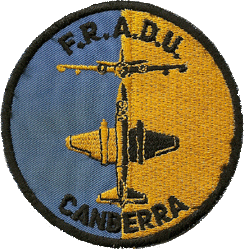

 |
THE FRADU CANBERRAS WEB-SITE |  |
| HISTORY OF THE NAVY & FRADU CANBERRAS |
 The Fleet Requirements and Air Direction Unit (FRADU) is currently operated, under contact to the Royal Navy by Serco Defence and Aerospace. Presently based at RNAS Culdrose in Cornwall, the Unit is equipped with 11 British Aerospace Hawk T.1 and T.1A aeroplanes, all of which were previously used by the Royal Air Force. Two airframes are permanently detached at RNAS Yeovilton and are used by the Naval Flying Standards Flight (fixed wing) and although flown by Fleet Air Arm pilots, are still maintained by FRADU's engineers. The FRADU's task sheet fulfils several roles that belie the name of the Unit, including support the Royal Navy's Task Fleet with Simulated Ship Attacks and airborne Early Warning (AEW) exercises. Fighter Controller training, nicknamed 'Direction School' is also carried out, as is Helicopter Fighter Affiliation training. FRADU's former aircraft, namely the Hunters and Canberras did this to a very high level for over twenty years. During the ship attacks FRADU maintains a close relationship with Cobham Plc (formerly Flight Refuelling Aviation (FRA)), which began in 1983 when its parent company Flight Refuelling Ltd won the contract to run the FRADU Unit on behalf of the Royal Navy. Cobham operate a large fleet of Dassault Falcon 20 aircraft from both Bournemouth and Teesside, and has done so since the first aeroplane arrived in 1985. FRADU's Hawks are often operated from bases in Mainland Europe as well as the UK, including previous deployments to France, Spain, and Portugal, as well as RAF Kinloss and RAF Waddington in the UK. |
| The original Navy Canberras
The Fleet Air Arm's association with the English Electric Canberra began in quiet fashion in May 1961. Six surplus Canberra B.2 airframes from the Royal Air Force were moved to Short Brothers' airfield at Belfast for conversion to U.14 specification. This would allow them to be operated by radio control on the ground without the need for a pilot in the cockpit. The first aeroplane delivered to the Fleet Air Arm was Canberra was WH921, when it arrived at RNAS Hal Far in Malta ready for service with 728B NAS (Navy Air Squadron) on 25th May 1961. The fleet code '590' was applied, and gradually the remaining five aeroplanes arrived from Belfast to join the Squadron and were coded in-sequence; WD941/591, WH720/592, WJ638/593, WH704/594 and WH876/595. All were painted overall white, with wide black bands on the outer wings. During August 1961, WH720/593 completed the first U.14 pilot-less flight in Fleet Air Arm service, and 728NAS began an intensive period of flying on guided missile trials involving the Armstrong Whitworth Seaslug weapon, the Canberras being operating alongside the Unit's existing fleet of Gloster Meteor U.15 and U.16s and Fairey Firefly U.9s. On 6th October 1961, WH921/590 was shot down by a missile fired from the Royal Navy warship HMS Girdle Ness, and the trials continued until the end of the test programme in December 1961. Now redundant, the five surviving airframes were withdrawn from Fleet Air Arm service and returned to the UK for storage at Pershore airfield and were left to varying fates. |